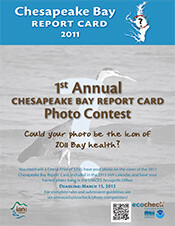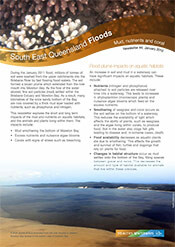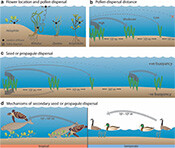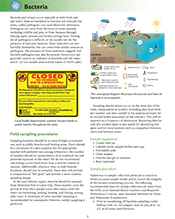Course in communicating science effectively
The Integration and Application Network is conducting a 3-day course in communicating science effectively. The course is being held in Cambridge, Maryland, 1-3 May, 2012. The hands-on approach means that participants come away from the course with the technical skills to effectively communicate scientific information in a variety of communication products. Further details and online registration are available on the course website.The 1st Annual Chesapeake Bay Report Card Photo Contest
 Do you have great photos from around the Bay? We want to see them! Your photo could be on the cover of the 2011 Chesapeake Bay Report Card and become the icon of 2011 Bay health. Last year was memorable for the weather, the lack of sea nettles, and, of course, your experiences on and around the Bay. Take a few minutes to look back on what you enjoyed last year and share those memories with us. Submit your photos from 2011 weather events, water quality monitoring, or that monster fish that you caught, by March 15th and you could win $250, your photo on the cover of the report card, inclusion in the 2013 IAN calendar, and have your framed photo hang in the UMCES Annapolis Office.
Do you have great photos from around the Bay? We want to see them! Your photo could be on the cover of the 2011 Chesapeake Bay Report Card and become the icon of 2011 Bay health. Last year was memorable for the weather, the lack of sea nettles, and, of course, your experiences on and around the Bay. Take a few minutes to look back on what you enjoyed last year and share those memories with us. Submit your photos from 2011 weather events, water quality monitoring, or that monster fish that you caught, by March 15th and you could win $250, your photo on the cover of the report card, inclusion in the 2013 IAN calendar, and have your framed photo hang in the UMCES Annapolis Office.
South East Queensland Floods 2011 newsletter #4
 During the January 2011 flood, millions of tonnes of soil were washed from the upper catchments into the Brisbane River by fast-flowing flood waters. The soil formed a brown plume which extended from the river mouth into Moreton Bay. As the flow of the water slowed, fine soil particles (mud) settled within the Brisbane Estuary and Moreton Bay. As a result, many kilometers of the once-sandy bottom of the Bay are now covered by a thick mud layer loaded with nutrients, such as phosphorus and nitrogen. This newsletter explores the short- and long-term impacts of the mud and nutrients on aquatic habitats and the animals and plants living within them. The impacts include mud smothering the bottom of Moreton Bay, excess nutrients and nuisance algae blooms, and corals with signs of stress such as bleaching.
During the January 2011 flood, millions of tonnes of soil were washed from the upper catchments into the Brisbane River by fast-flowing flood waters. The soil formed a brown plume which extended from the river mouth into Moreton Bay. As the flow of the water slowed, fine soil particles (mud) settled within the Brisbane Estuary and Moreton Bay. As a result, many kilometers of the once-sandy bottom of the Bay are now covered by a thick mud layer loaded with nutrients, such as phosphorus and nitrogen. This newsletter explores the short- and long-term impacts of the mud and nutrients on aquatic habitats and the animals and plants living within them. The impacts include mud smothering the bottom of Moreton Bay, excess nutrients and nuisance algae blooms, and corals with signs of stress such as bleaching.
The Central Role of Dispersal in the Maintenance and Persistence of Seagrass Populations
 Global seagrass losses parallel significant declines in corals and mangroves over the past 50 years. These combined declines have resulted in accelerated global losses to ecosystem services in coastal waters. Seagrass meadows can be extensive and long-lived. This article explores the role that sexual reproduction, pollen, and seed dispersal play in maintaining species distributions, genetic diversity, and connectivity among populations. It also addresses the relationship between long-distance dispersal, genetic connectivity, and the maintenance of genetic diversity that may enhance resilience to stresses associated with seagrass loss. This re-evaluation of seagrass dispersal and recruitment has altered the perception of the importance of long-distance dispersal and has revealed extensive dispersal at scales much larger than was previously thought possible.
Global seagrass losses parallel significant declines in corals and mangroves over the past 50 years. These combined declines have resulted in accelerated global losses to ecosystem services in coastal waters. Seagrass meadows can be extensive and long-lived. This article explores the role that sexual reproduction, pollen, and seed dispersal play in maintaining species distributions, genetic diversity, and connectivity among populations. It also addresses the relationship between long-distance dispersal, genetic connectivity, and the maintenance of genetic diversity that may enhance resilience to stresses associated with seagrass loss. This re-evaluation of seagrass dispersal and recruitment has altered the perception of the importance of long-distance dispersal and has revealed extensive dispersal at scales much larger than was previously thought possible.
Bacteria sampling and data analysis protocol
 This document develops a clear and consistent protocol for the identification, collection, and analysis of the indicator of bacteria. Specifically, this document serves as an addendum to the Sampling and data analysis protocols for Mid-Atlantic tidal tributary indicators which provides guidelines for the successful production of tidal ecosystem health report cards. The bacteria protocol was written and reviewed by the MTAC group and Ecocheck. This document is intended for use in tidal areas only, as the ecosystem health indicator and thresholds discussed are pertinent only to tidal ecosystems.
This document develops a clear and consistent protocol for the identification, collection, and analysis of the indicator of bacteria. Specifically, this document serves as an addendum to the Sampling and data analysis protocols for Mid-Atlantic tidal tributary indicators which provides guidelines for the successful production of tidal ecosystem health report cards. The bacteria protocol was written and reviewed by the MTAC group and Ecocheck. This document is intended for use in tidal areas only, as the ecosystem health indicator and thresholds discussed are pertinent only to tidal ecosystems.

